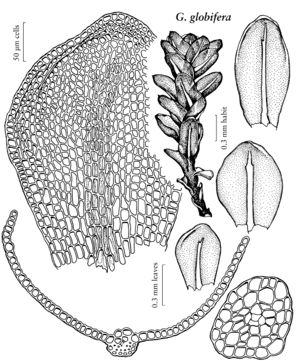Globulinella
J. Wash. Acad. Sci. 36: 221. 1946 ,.
| Taxon | Illustrator ⠉ | |
|---|---|---|
 | Globulinella globifera | Patricia M. Eckel |
Plants small, in tufts or gregarious; dark green to golden brown or reddish-brown. Stems 1–5 mm, simple or forked; scleroderm present, central strand well developed; axillary hairs short, with hyaline or light-brown basal-cell. Stem-leaves appressed when dry, erect when wet, oblong-ovate to spathulate, obovate or orbicular, concave above, quickly tapering to base, margins entire to somewhat wavy, plane proximally, erect to broadly incurved above; apex broadly rounded, cucullate; costae single, ending below apex, frequently spurred above, distal adaxial cells quadrate to shortrectangular, enlarged and bulging above; in cross-section with single row of guide cells, adaxial cells similar in size to guide cells, somewhat thickened, abaxial stereid or substereid band well developed, epidermal-cells somewhat larger, thickened; laminal cells smooth, rectangular, thickened, medial laminal cells roundedquadrate, oblate or shortrectangular, smooth, thickened, distal cells quadrate to angular, thickened or incrassate, alar and marginal cells not differentiated. Specialized asexual reproduction by gemmae, rare, clavate to spherical, in leaf-axils. Sexual condition dioicous. Perichaetia terminal, interior leaves little differentiated or somewhat sheathing. Seta elongate, redbrown, smooth. Capsule stegocarpous, theca oblong, operculum conic-rostrate; peristome teeth 16, cleft and irregular, erect from very short basal membrane. Calyptra small, cucullate, smooth. Spores 8–12 µm, round, weakly papillose. KOH laminal color reaction yellow.
Distribution
North America, Central America, South America in temperate and tropical areas
Discussion
Species 2 (1 in flora).
Globulinella can be recognized by its small stature, spathulate or oval leaves with broadly rounded, cucullate apex, and strong, laterally spurred costa ending below the apex. The plants grow in crevices or protected places on the sides of calcareous boulders or ledges. Gemmae have been reported by R. H. Zander (1993) from a Mexican collection.